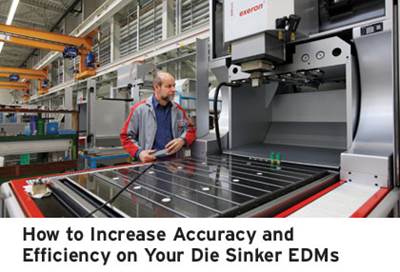Soft Wire Threading for Wire EDM’ing: Tips for Success
Look for EDM equipment that provides improved wire processing during the AWF cycle. Technology should include a way to precisely control the wire tension and energy used to cut the wire.
Moldmakers using wire EDM face challenges when cutting high taper angles. Often EDM machines have the axis movement necessary to achieve the desired angle, but the physical properties of the wire and related machine technology may not be adequate.
Low tensile strength soft wire—needed to cut high tapers—is sensitive to the voltages and tension applied to it by the EDM machine during the AWF cutting cycle. If not handled properly, the result is a malformed wire tip, which is curved, preventing the wire from being able to be inserted into the wire guides. In these instances, the machine is unable to thread or re-thread the wire, so the erosion process is stopped and production time is lost.
To help solve this problem, look for EDM equipment that provides improved wire processing during the AWF cycle. Technology should include a way to precisely control the wire tension and energy used to cut the wire.
The ideal AWF situation is one where the wire heats and stretches until it breaks in two without melting. EDM machines that offer the ability to have cool air directed to the wire cut point, keeping the wire tip as cool as possible and preventing a molten tip to be produced during a thermal wire cutting process is very helpful.
To optimize the threading cutting cycle, rely on a timer to open an air solenoid to gently blow cool air onto the wire cutting electrode to keep the wire tip from heating up to a melting stage.
Accurately controlling wire tension is critical, especially with soft wire, during the cutting phase. An AWF system that includes a wire tension monitoring device enabling continuous observation is important.
And to maintain wire tension, EDM systems that include a dual AC motor and encoder wire drive system working in tandem to enable the tension motor and drive roller to communicate energy usage to the controller are very useful.
Some other useful tips for working with soft wire include: (1) use a die guide designed for large taper cutting, especially if you are going to skim cut the large tapers to improve surface finish and accuracy. These guides have a much larger support to help the wire transition thru the large angles’ (2) to ensure accuracy, use the features in the CNC that compensate for the changing position (in Z-Axis direction) so that the taper angles are precise; and , (3) if the cutting technology being used was developed for hard brass wire, the wire tension will have to be reduced on the rough cut.
Related Content
6 Ways to Optimize High-Feed Milling
High-feed milling can significantly outweigh potential reliability challenges. Consider these six strategies in order to make high-feed milling successful for your business.
Read MoreTreatment and Disposal of Used Metalworking Fluids
With greater emphasis on fluid longevity and fluid recycling, it is important to remember that water-based metalworking fluids are “consumable” and have a finite life.
Read MoreRevisiting Some Hot Runner Fundamentals
What exactly does a hot runner do? If you’ve been in the injection molding industry for any length of time, you might think the answer is obvious, but it is not.
Read MoreMachine Hammer Peening Automates Mold Polishing
A polishing automation solution eliminates hand work, accelerates milling operations and controls surface geometries.
Read MoreRead Next
How to Increase Accuracy and Efficiency on Your Die Sinker EDM
A look at reducing the size of the die sinker’s power supply and decreasing the amount of energy consumed during erosion.
Read MoreHow to Use Continuing Education to Remain Competitive in Moldmaking
Continued training helps moldmakers make tooling decisions and properly use the latest cutting tool to efficiently machine high-quality molds.
Read MoreHow to Use Strategic Planning Tools, Data to Manage the Human Side of Business
Q&A with Marion Wells, MMT EAB member and founder of Human Asset Management.
Read More





















